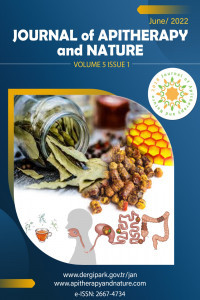Antioxidant Activities of Propolis from Aragón (Spain)
Antioxidant Activities of Propolis from Aragón (Spain)
Propolis,
___
- 1. Daleprane JB, Abdalla DS (2013) Emerging Roles of Propolis: Antioxidant, Cardioprotective, and Antiantiogenic Actions. Evidence-Based Complementary and Alternative Medicine 2013: 1-8.
- 2. Bankova V. (2005) Chemical diversity of propolis and the problem of standardization. Journal of Ethnopharmacology 100: 114-117.
- 3. Prior RL, Wu X, Schaich K, (2005) Standardized Methods for the Determination of Antioxidant Capacity and Phenolics in Foods and Dietary Supplements. Journal of Agricultural and Food chemistry 53: 4290-4302.
- 4. Huang D, Ou B, Hampsch-Woodill M, Flanagan JA, Prior RL (2002) High-Throughput Assay of Oxygen Radical Absorbance Capacity (ORAC) Using a Multichannel Liquid Handling System Coupled with a Microplate Fluorescence Reader in 96-Well Format. Journal of Agricultural and Food chemistry 50: 4437–4444.
- 5. Osés SM, Pascual-Maté A, Fernández-Muiño MA, López-Díaz TM, Sancho MT (2016) Bioactive properties of honey with propolis. Food chemistry 196: 1215-1223.
- 6. Miguel MG, Nunes S, Dandlen SA, Cavaco AM, Antunes MD (2010) Phenols and antioxidant activity of hydro-alcoholic extracts of propolis from Algarve, South of Portugal. Food and Chemical Toxicology 48: 3418-3423
- Yayın Aralığı: Yılda 2 Sayı
- Başlangıç: 2018
- Yayıncı: Oktay YILDIZ
In Vitro Evaluation of Green and Red Propolis Extracts Against Candida spp
M. D. FREITAS, G. A. LOPES, N. A OLIVEIRA, B. M. ALMEIDA, S. R. L. ABREU, R. C. BASQUES, N. S. BINDA, S. M. FIGUEIREDO
İvan MISKULIN, İvana KLARIC, Matija DOMACINOVIC, Berislav PRAKATUR, Mirela PAVIC, Mario RONTA, Maja MISKULIN
Phenolic Compounds of Spain Propolis
Félix ADANERO-JORGE, M Camino GARCÍA-FERNÁNDEZ, Rosa M VALENCIA-BARRERA, J. Javier SANZ-GÓMEZ
Portuguese Propolis: A Potenial Source of Environmentally Friendly Fungicides
Catarina PASSÃO, Claudia RODRIGUES, Cristina Almeida AGUIAR, Ana CUNHA
The Effect of Propolis on Selected Blood Parameters of Broilers
İvan MISKULIN, İvana KLARIC, Matija DOMACINOVIC, Berislav PRAKATUR, Zvonimir STEINER, Vatroslav SERIC, Maja MISKULIN
María İnmaculada GONZÁLEZ-MARTÍN, Eddy Valentín BETANCES-SALCEDO, İsabel REVILLA, Ana María VIVAR-QUINTANA
The Influence of Propolis on Liver Pathology in Broilers
Maja MISKULIN, Ivana KLARIC, Matija DOMACINOVIC, Berislav PRAKATUR, Albina DUMIC, Daniela Cacic KENJERIC, İvan MISKULIN
Fatty Acid Analysis and Biological Activity of Jordanian Propolis
Ashok K. SHAKYA, Shankar KATEKHAYE, Ghaleb A. ORIQUAT, Rajashri R. NAIK, Rajashri R. NAIK, Anant PARADKAR, Hugo FEARNLEY, James FEARNLEY
GC-MS and UPLCA-PDA-TOF Profile of Polish and Eurasian Propolis
Jarosław WIDELSKI, Piotr OKIŃCZYC, Antoni SZUMNY, Jakub SZPERLIK, Anna KULMA, Zbigniew SROKA, Krystyna SKALICKA-WOŹNIAK, Tomasz MROCZEK
Toothpaste with Propolis “Apident” Shows Antimicrobial Activity in vitro
Klemen RIHAR, Dunja Gregorič EXEL, Adriana PEREYRA, Rok KOPINČ, Bratko FILIPIČ
